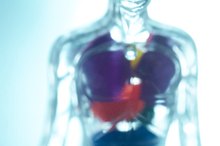What Are the Causes of a Swollen Kidney?
Your kidneys serve a vital role in removing waste and excess fluid from your body through urination. Sometimes one of the kidneys becomes swollen. A swollen kidney is generally due to a serious disorder that requires medical attention. Causes may range from kidney infection to kidney cysts, a kidney tumor, blockage of blood flow to or from the kidney or urine accumulation in the kidney, called hydronephrosis 5.
Kidney Infection
An infection in the kidney, called pyelonephritis, usually originates as an infection in the bladder, called cystitis. The kidney becomes infected when bacteria in the bladder move up through the ureter -- the tube connecting the kidney to the bladder. Less commonly, bacteria enter the kidney directly from the bloodstream.
Pyelonephritis causes inflammation with swelling of the kidney. It often produces pain in the flank or back, fever, nausea and vomiting.
Blood may be seen in the urine, especially in women. Kidney infections require treatment with antibiotics.
- An infection in the kidney, called pyelonephritis, usually originates as an infection in the bladder, called cystitis.
- Pyelonephritis causes inflammation with swelling of the kidney.
Hydronephrosis
Signs and Symptoms of Enlarged Kidneys
Learn More
Accumulation of urine in the kidney is usually caused by partial or complete blockage of the ureter, preventing normal flow of urine to the bladder.
**Blockage is often caused by a kidney stone or blood clot within the ureter.
** Other causes include narrowing of the ureter by an injury, surgery or infection in or around the ureter. If the blockage is left untreated, hydronephrosis can impair kidney function and eventually lead to kidney failure 5.
- Accumulation of urine in the kidney is usually caused by partial or complete blockage of the ureter, preventing normal flow of urine to the bladder.
- Blockage is often caused by a kidney stone or blood clot within the ureter.
Blocked Blood Flow
The kidneys receive blood through renal arteries.
If blood flow into the kidney is partially or totally blocked, kidney cells will die because of lack of oxygen and other nutrients. This causes kidney infarction, characterized by swelling of the dying cells and surrounding tissue. Blockage of blood flow into the kidney is often caused by cholesterol-containing plaques -- atherosclerosis -- of the renal artery or the main artery of the abdomen, called the aorta.
Blood leaves the kidneys through renal veins.
If blood flow from a kidney is partially or totally blocked, blood will accumulate inside the kidney, causing swelling. Renal vein blockage may be caused by a blood clot. This is often due to a coagulation disorder that causes a person to develop blood clots in various parts of the body. Abdominal tumors that compress the renal vein or grow into the vein are other possible causes.
- The kidneys receive blood through renal arteries.
- This causes kidney infarction, characterized by swelling of the dying cells and surrounding tissue.
Kidney Cysts and Tumors
What Are the Causes of Swollen Testicles?
Learn More
Fluid-filled sacs in the kidney, called renal cysts, can cause kidney swelling.
Renal cysts are usually benign but are occasionally cancerous. They may occur as single or many cysts.
Unilateral renal cystic disease is a rare disorder characterized by multiple cysts in just one kidney 2. It generally causes no symptoms and does not interfere with normal kidney function.
Kidney tumors may also cause swelling of one kidney. These tumors may be benign or cancerous. Kidney cancer is the eighth most common cancer in the United States, according to the National Cancer Institute 6.
In the early stages of kidney cancer, there are usually no symptoms.
Flank pain, blood in the urine and fever often appear with more advanced disease. Sometimes kidney cancer enters the renal vein or causes a blood clot to form in the renal vein, producing further swelling of the kidney.
- Fluid-filled sacs in the kidney, called renal cysts, can cause kidney swelling.
- Unilateral renal cystic disease is a rare disorder characterized by multiple cysts in just one kidney 2.
Other Causes
When one kidney is surgically removed, often as treatment for cancer, the remaining kidney may swell as it takes over the function of both kidneys.
Disorders that cause swelling of both kidneys may primarily affect one kidney, especially early in the course of the disease. For example, early-stage kidney disease caused by diabetes typically produces kidney swelling, which may sometimes be apparent in just one kidney.
Reviewed and revised by: Mary D. Daley, MD
- When one kidney is surgically removed, often as treatment for cancer, the remaining kidney may swell as it takes over the function of both kidneys.
Related Articles
References
- Journal of the American Osteopathic College of Radiology: Unilateral Renal Enlargement
- Nephrology Dialysis Transplantation: Unilateral Renal Cystic Disease in Adults
- Cleveland Clinic Center for Continuing Education: Diabetic Nephropathy
- National Health Services Choices: Hydronephrosis
- National Kidney Foundation: Hydronephrosis
- National Cancer Institute: Cancer Stat Facts -- Kidney and Renal Pelvis Cancer
- Merck Manual Professional Version: Renal Cell Carcinoma
- American Cancer Society. Types of kidney cancer
- American Cancer Society. About the kidneys
- American Cancer Society. Kidney Cancer Signs and Symptoms
- American Cancer Society. Risk Factors for Kidney Cancer
- American Cancer Society. Tests for Kidney Cancer
- American Cancer Society. Kidney Cancer Stages
- American Cancer Society. Surgery for Kidney Cancer
- American Cancer Society. Targeted Therapy for Kidney Cancer
- American Cancer Society. Immunotherapy for Kidney Cancer
- American Cancer Society. Radiation Therapy for Kidney Cancer
- American Society of Clinical Oncology. Cancer.Net. Kidney Cancer.
- Bast R, Croce C, Hait W. et al. Holland-Frei Cancer Medicine. Wiley Blackwell, 2017.
- National Cancer Institute. Renal Cell Cancer Treatment (PDQ)—Health Professional Version. Updated 04/05/18.
Writer Bio
Aubri John has been a contributing researcher and writer to online physical and mental health oriented journals since 2005. John publishes online health and fitness articles that coincide with her licensed clinical skills in addictions, psychology and medical care. She has a master's degree in clinical social work and a Ph.D. in health psychology.






